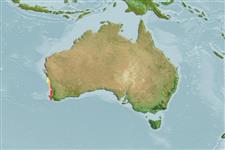>
Centrarchiformes (Basses) >
Kyphosidae (Sea chubs)
Etymology: Kyphosus: Greek, kyphos = bent (Ref. 45335); gladius: Named for its body shape, resembling the roman gladius sword (widest towards the point and tapers towards the hilt) with the relatively elongate body and shallow caudal peduncle, along with the metallic-bluish colouration..
Environment: milieu / climate zone / depth range / distribution range
Ecologie
marien; diepte 0 - 15 m (Ref. 92523). Subtropical; 28°S - 35°S, 113°E - 118°E (Ref. 92523)
Eastern Indian Ocean: endemic to Western Australia.
Grootte / Gewicht / Leeftijd
Maturity: Lm ? range ? - ? cm
Max length : 45.7 cm SL mannelijk / geslacht onbekend; (Ref. 92523)
Korte beschrijving
Determinatiesleutels | Morfologie | Morfometrie
Dorsale stekels (totaal) : 10 - 11; Dorsale zachte stralen (totaal) : 11 - 12; Anale stekels: 3; Anale zachte stralen: 11 - 12; Wervels: 26. This species is distinguished from its congeners from the Indian Ocean and the Pacific Ocean by the following set of characters: body elliptical and elongate in lateral view and compressed; D X-XI,11-12; A III,11-12, anal fin base short 16.9-20.6% SL; total gill rakers externally 15-19, gill rakers on upper limb externally 3-5, gill rakers on lower limb externally 11-15; long caudal peduncle 18.7-26.5%SL (depth 9.9-11.8% SL); total lateral line 55-64, pored scales 44-55, scale rows in longitudinal row 49-57; precaudal- and caudal vertebrae 10+16; pterygiophores, dorsal 21, anal 12; mouth terminal; silvery line under eye, colour silvery to bluish metallic; operculum with a vertical green bar running down rear of preoperculum; dorsal part of body without dark counter-shading; sixth dorsal fin spine length, 8.7-11.9 % SL; body depth, 33.3-41.6 % SL (Ref. 92523).
Maximum length of individuals observed from the wild may be in excess of 52 cm SL (Ref. 92523).
Levenscyclus en paargedrag
Maturities | Voortplanting | Spawnings | Egg(s) | Fecundities | Larven
Knudsen, S.W. and K.D. Clements, 2013. Revision of the fish family Kyphosidae (Teleostei: Perciformes). Zootaxa 3751(1):001-101. (Ref. 95491)
Status op de Rode Lijst van het IUCN (Ref. 130435)
Gevaar voor de mens
Harmless
Gebruik door de mens
Tools
Speciale rapporten
Download XML
Internetbronnen
Estimates based on models
Preferred temperature (Ref.
123201): 19.3 - 21.2, mean 20.6 °C (based on 16 cells).
Fylogenetische diversiteitsindex (Ref.
82804): PD
50 = 0.5000 [Uniqueness, from 0.5 = low to 2.0 = high].
Bayesian length-weight: a=0.00389 (0.00180 - 0.00842), b=3.12 (2.94 - 3.30), in cm total length, based on all LWR estimates for this body shape (Ref.
93245).
Weerstandsvermogen (Ref.
120179): Gemiddeld, minimale populatieverdubbelingstijd 1,4-4,4 jaar (Preliminary K or Fecundity.).
Fishing Vulnerability (Ref.
59153): Moderate vulnerability (42 of 100).
Nutrients (Ref.
124155): Calcium = 101 [47, 189] mg/100g; Iron = 1.23 [0.66, 2.21] mg/100g; Protein = 18.3 [17.1, 19.5] %; Omega3 = 0.165 [0.083, 0.328] g/100g; Selenium = 17.9 [7.8, 42.5] μg/100g; VitaminA = 11.6 [2.5, 50.8] μg/100g; Zinc = 1.28 [0.87, 1.91] mg/100g (wet weight);
